tailgate MITSUBISHI OUTLANDER PHEV 2016 (in English) Service Manual
[x] Cancel search | Manufacturer: MITSUBISHI, Model Year: 2016, Model line: OUTLANDER PHEV, Model: MITSUBISHI OUTLANDER PHEV 2016Pages: 490, PDF Size: 22.02 MB
Page 165 of 490
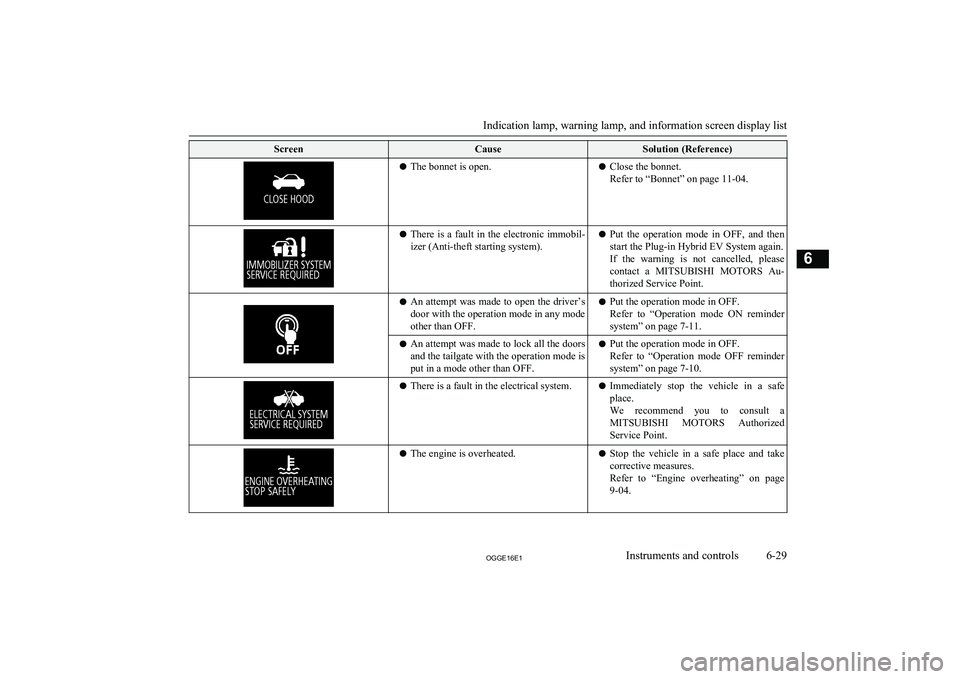
ScreenCauseSolution (Reference)lThe bonnet is open.lClose the bonnet.
Refer to “Bonnet” on page 11-04.l There is a fault in the electronic immobil-
izer (Anti-theft starting system).l Put the operation mode in OFF, and then
start the Plug-in Hybrid EV System again.If the warning is not cancelled, please
contact a MITSUBISHI MOTORS Au-
thorized Service Point.l An attempt was made to open the driver’s
door with the operation mode in any mode
other than OFF.l Put the operation mode in OFF.
Refer to “Operation mode ON reminder system” on page 7-11.l An attempt was made to lock all the doors
and the tailgate with the operation mode is
put in a mode other than OFF.l Put the operation mode in OFF.
Refer to “Operation mode OFF reminder system” on page 7-10.l There is a fault in the electrical system.l Immediately stop the vehicle in a safe
place.
We recommend you to consult a
MITSUBISHI MOTORS Authorized
Service Point.l The engine is overheated.lStop the vehicle in a safe place and take
corrective measures.
Refer to “Engine overheating” on page 9-04.
Indication lamp, warning lamp, and information screen display list
6-29OGGE16E1Instruments and controls6
Page 205 of 490
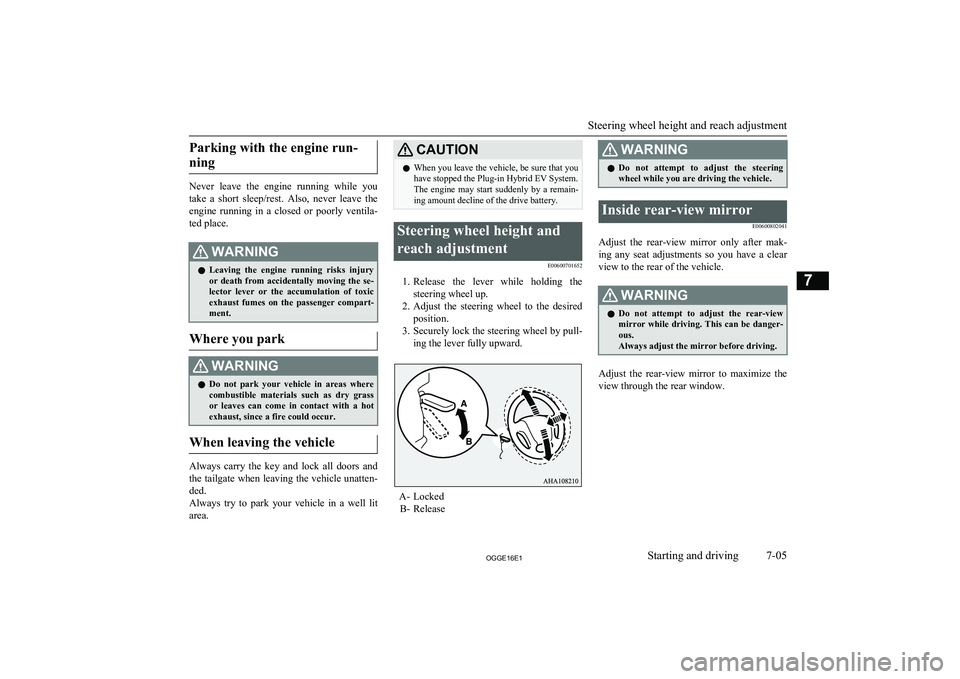
Parking with the engine run-ning
Never leave the engine running while you
take a short sleep/rest. Also, never leave the engine running in a closed or poorly ventila-
ted place.
WARNINGl Leaving the engine running risks injury
or death from accidentally moving the se-
lector lever or the accumulation of toxic
exhaust fumes on the passenger compart- ment.
Where you park
WARNINGl Do not park your vehicle in areas where
combustible materials such as dry grass
or leaves can come in contact with a hot exhaust, since a fire could occur.
When leaving the vehicle
Always carry the key and lock all doors and
the tailgate when leaving the vehicle unatten-
ded.
Always try to park your vehicle in a well lit
area.
CAUTIONl When you leave the vehicle, be sure that you
have stopped the Plug-in Hybrid EV System.
The engine may start suddenly by a remain-
ing amount decline of the drive battery.Steering wheel height and
reach adjustment E00600701652
1.Release the lever while holding the
steering wheel up.
2. Adjust the steering wheel to the desired
position.
3. Securely lock the steering wheel by pull-
ing the lever fully upward.
A- Locked B- Release
WARNINGl Do not attempt to adjust the steering
wheel while you are driving the vehicle.Inside rear-view mirror
E00600802041
Adjust the rear-view mirror only after mak-
ing any seat adjustments so you have a clear
view to the rear of the vehicle.
WARNINGl Do not attempt to adjust the rear-view
mirror while driving. This can be danger-
ous.
Always adjust the mirror before driving.
Adjust the rear-view mirror to maximize the
view through the rear window.
Steering wheel height and reach adjustment
7-05OGGE16E1Starting and driving7
Page 211 of 490
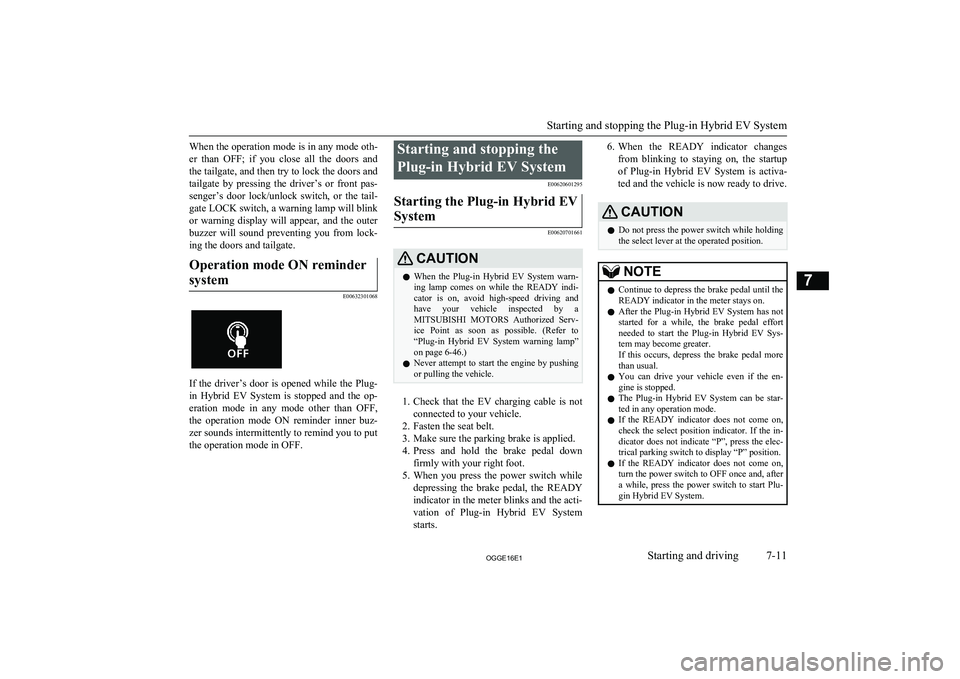
When the operation mode is in any mode oth-er than OFF; if you close all the doors and the tailgate, and then try to lock the doors and
tailgate by pressing the driver’s or front pas- senger’s door lock/unlock switch, or the tail-
gate LOCK switch, a warning lamp will blink or warning display will appear, and the outer
buzzer will sound preventing you from lock-
ing the doors and tailgate.Operation mode ON reminder
system
E00632301068
If the driver’s door is opened while the Plug- in Hybrid EV System is stopped and the op-
eration mode in any mode other than OFF, the operation mode ON reminder inner buz-
zer sounds intermittently to remind you to put
the operation mode in OFF.
Starting and stopping the
Plug-in Hybrid EV System E00620601295Starting the Plug-in Hybrid EV
System
E00620701661
CAUTIONl When the Plug-in Hybrid EV System warn-
ing lamp comes on while the READY indi- cator is on, avoid high-speed driving and
have your vehicle inspected by a
MITSUBISHI MOTORS Authorized Serv-
ice Point as soon as possible. (Refer to “Plug-in Hybrid EV System warning lamp” on page 6-46.)
l Never attempt to start the engine by pushing
or pulling the vehicle.
1. Check that the EV charging cable is not
connected to your vehicle.
2. Fasten the seat belt.
3. Make sure the parking brake is applied.
4. Press and hold the brake pedal down
firmly with your right foot.
5. When you press the power switch while
depressing the brake pedal, the READY indicator in the meter blinks and the acti-
vation of Plug-in Hybrid EV System
starts.
6. When the READY indicator changes
from blinking to staying on, the startup of Plug-in Hybrid EV System is activa-ted and the vehicle is now ready to drive.CAUTIONl Do not press the power switch while holding
the select lever at the operated position.NOTEl Continue to depress the brake pedal until the
READY indicator in the meter stays on.
l After the Plug-in Hybrid EV System has not
started for a while, the brake pedal effort needed to start the Plug-in Hybrid EV Sys-tem may become greater.
If this occurs, depress the brake pedal more
than usual.
l You can drive your vehicle even if the en-
gine is stopped.
l The Plug-in Hybrid EV System can be star-
ted in any operation mode.
l If the READY indicator does not come on,
check the select position indicator. If the in-
dicator does not indicate “P”, press the elec-
trical parking switch to display “P” position.
l If the READY indicator does not come on,
turn the power switch to OFF once and, after a while, press the power switch to start Plu- gin Hybrid EV System.
Starting and stopping the Plug-in Hybrid EV System
7-11OGGE16E1Starting and driving7
Page 285 of 490
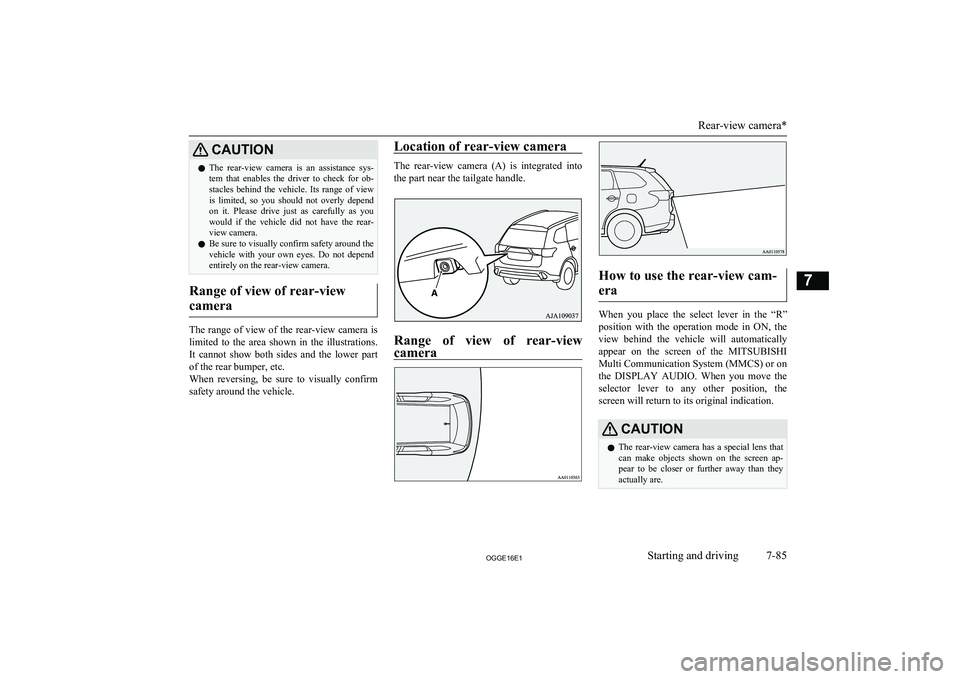
CAUTIONlThe rear-view camera is an assistance sys-
tem that enables the driver to check for ob- stacles behind the vehicle. Its range of view
is limited, so you should not overly depend on it. Please drive just as carefully as you
would if the vehicle did not have the rear-
view camera.
l Be sure to visually confirm safety around the
vehicle with your own eyes. Do not depend entirely on the rear-view camera.
Range of view of rear-view
camera
The range of view of the rear-view camera is
limited to the area shown in the illustrations.
It cannot show both sides and the lower part of the rear bumper, etc.
When reversing, be sure to visually confirm safety around the vehicle.
Location of rear-view camera
The rear-view camera (A) is integrated into
the part near the tailgate handle.
Range of view of rear-viewcamera
How to use the rear-view cam-
era
When you place the select lever in the “R”
position with the operation mode in ON, the view behind the vehicle will automatically
appear on the screen of the MITSUBISHI
Multi Communication System (MMCS) or on
the DISPLAY AUDIO. When you move the
selector lever to any other position, the screen will return to its original indication.
CAUTIONl The rear-view camera has a special lens that
can make objects shown on the screen ap-
pear to be closer or further away than they
actually are.
Rear-view camera*
7-85OGGE16E1Starting and driving7
Page 288 of 490
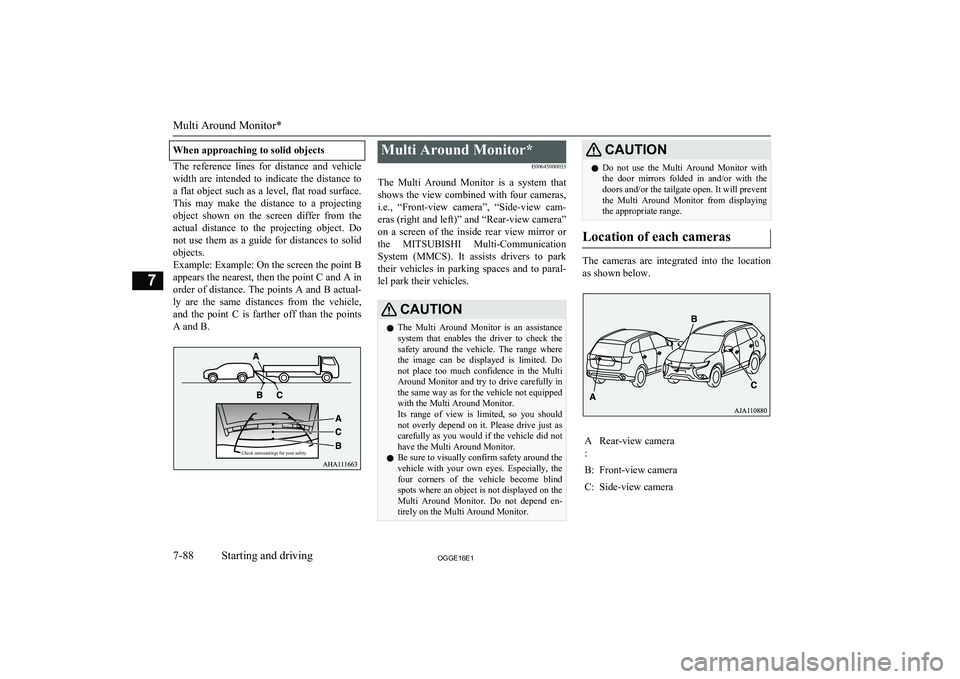
When approaching to solid objects
The reference lines for distance and vehicle
width are intended to indicate the distance to a flat object such as a level, flat road surface. This may make the distance to a projecting
object shown on the screen differ from the
actual distance to the projecting object. Do not use them as a guide for distances to solid
objects.
Example: Example: On the screen the point B appears the nearest, then the point C and A in
order of distance. The points A and B actual-
ly are the same distances from the vehicle, and the point C is farther off than the points
A and B.
Multi Around Monitor*
E00645000033
The Multi Around Monitor is a system that shows the view combined with four cameras,i.e., “Front-view camera”, “Side-view cam- eras (right and left)” and “Rear-view camera”
on a screen of the inside rear view mirror or the MITSUBISHI Multi-Communication
System (MMCS). It assists drivers to park
their vehicles in parking spaces and to paral- lel park their vehicles.CAUTIONl The Multi Around Monitor is an assistance
system that enables the driver to check the
safety around the vehicle. The range where the image can be displayed is limited. Do
not place too much confidence in the Multi
Around Monitor and try to drive carefully in
the same way as for the vehicle not equipped with the Multi Around Monitor.
Its range of view is limited, so you should not overly depend on it. Please drive just as
carefully as you would if the vehicle did not
have the Multi Around Monitor.
l Be sure to visually confirm safety around the
vehicle with your own eyes. Especially, the four corners of the vehicle become blindspots where an object is not displayed on the
Multi Around Monitor. Do not depend en-
tirely on the Multi Around Monitor.CAUTIONl Do not use the Multi Around Monitor with
the door mirrors folded in and/or with the doors and/or the tailgate open. It will prevent
the Multi Around Monitor from displaying
the appropriate range.
Location of each cameras
The cameras are integrated into the location
as shown below.
A
:Rear-view cameraB:Front-view cameraC:Side-view camera
Multi Around Monitor*
7-88OGGE16E1Starting and driving7Check surroundings for your safety.
Page 297 of 490
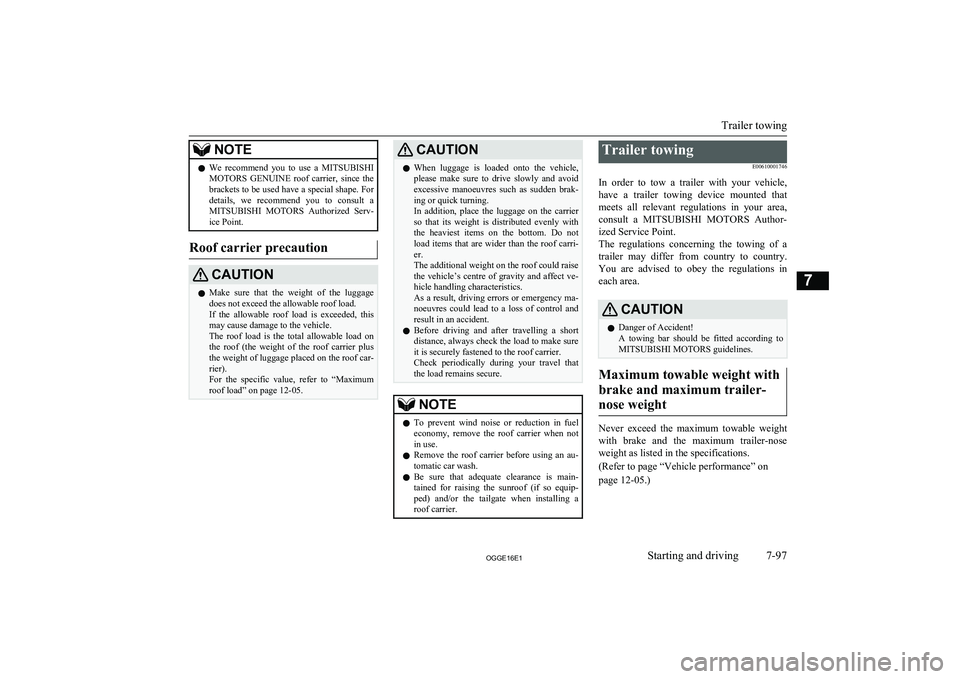
NOTElWe recommend you to use a
MITSUBISHI
MOTORS GENUINE roof carrier, since the
brackets to be used have a special shape. For details, we recommend you to consult aMITSUBISHI MOTORS Authorized Serv-
ice Point.
Roof carrier precaution
CAUTIONl Make sure that the weight of the luggage
does not exceed the allowable roof load.
If the allowable roof load is exceeded, this may cause damage to the vehicle.
The roof load is the total allowable load on
the roof (the weight of the roof carrier plus
the weight of luggage placed on the roof car- rier).
For the specific value, refer to “Maximum
roof load” on page 12-05.CAUTIONl When luggage is loaded onto the vehicle,
please make sure to drive slowly and avoid
excessive manoeuvres such as sudden brak- ing or quick turning.
In addition, place the luggage on the carrier
so that its weight is distributed evenly with the heaviest items on the bottom. Do not load items that are wider than the roof carri-
er.
The additional weight on the roof could raise
the vehicle’s centre of gravity and affect ve-
hicle handling characteristics.
As a result, driving errors or emergency ma- noeuvres could lead to a loss of control and
result in an accident.
l Before driving and after travelling a short
distance, always check the load to make sure
it is securely fastened to the roof carrier.
Check periodically during your travel that the load remains secure.NOTEl To prevent wind noise or reduction in fuel
economy, remove the roof carrier when not
in use.
l Remove the roof carrier before using an au-
tomatic car wash.
l Be sure that adequate clearance is main-
tained for raising the sunroof (if so equip-
ped) and/or the tailgate when installing a roof carrier.Trailer towing
E00610001746
In order to tow a trailer with your vehicle,
have a trailer towing device mounted that
meets all relevant regulations in your area, consult a MITSUBISHI MOTORS Author-
ized Service Point.
The regulations concerning the towing of a
trailer may differ from country to country. You are advised to obey the regulations in
each area.CAUTIONl Danger of Accident!
A towing bar should be fitted according to MITSUBISHI MOTORS guidelines.
Maximum towable weight with
brake and maximum trailer- nose weight
Never exceed the maximum towable weight
with brake and the maximum trailer-nose weight as listed in the specifications.
(Refer to page “Vehicle performance” on
page 12-05.)
Trailer towing
7-97OGGE16E1Starting and driving7
Page 376 of 490
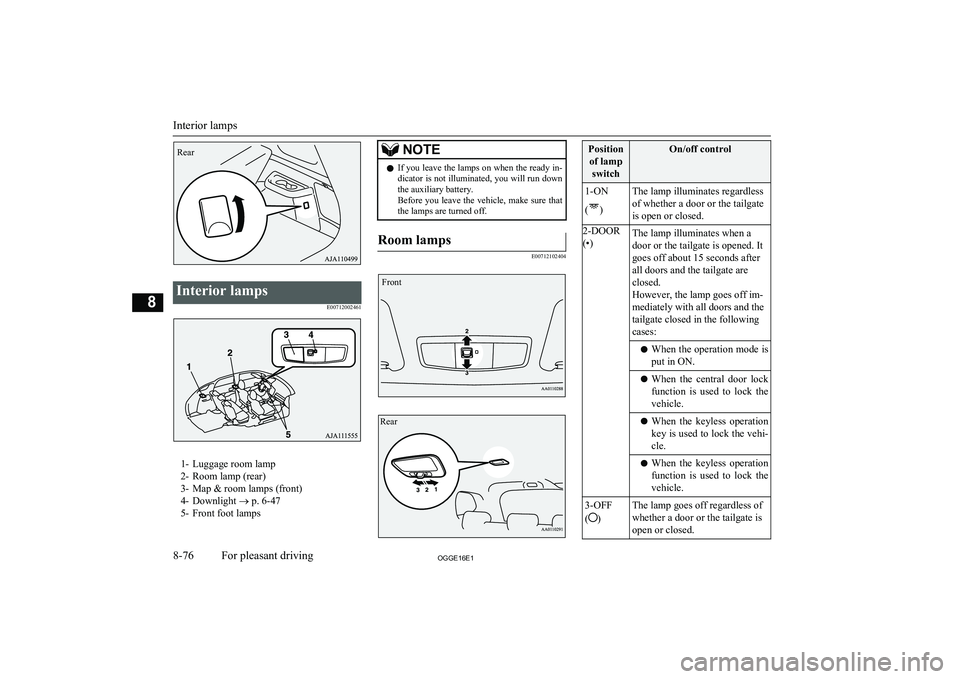
Interior lampsE00712002461
1- Luggage room lamp
2- Room lamp (rear)
3- Map & room lamps (front)
4- Downlight ® p. 6-47
5- Front foot lamps
NOTEl If you leave the lamps on when the ready in-
dicator is not illuminated, you will run down the auxiliary battery.
Before you leave the vehicle, make sure that
the lamps are turned off.Room lamps
E00712102404
Position
of lamp switchOn/off control1-ON
(
)
The lamp illuminates regardless
of whether a door or the tailgate
is open or closed.2-DOOR
(•)The lamp illuminates when a
door or the tailgate is opened. It
goes off about 15 seconds after
all doors and the tailgate are
closed.
However, the lamp goes off im-
mediately with all doors and the
tailgate closed in the following
cases:l When the operation mode is
put in ON.l When the central door lock
function is used to lock thevehicle.l When the keyless operation
key is used to lock the vehi-cle.l When the keyless operation
function is used to lock thevehicle.3-OFF
(
)
The lamp goes off regardless of
whether a door or the tailgate is
open or closed.
Interior lamps
8-76OGGE16E1For pleasant driving8Rear Front Rear
Page 377 of 490
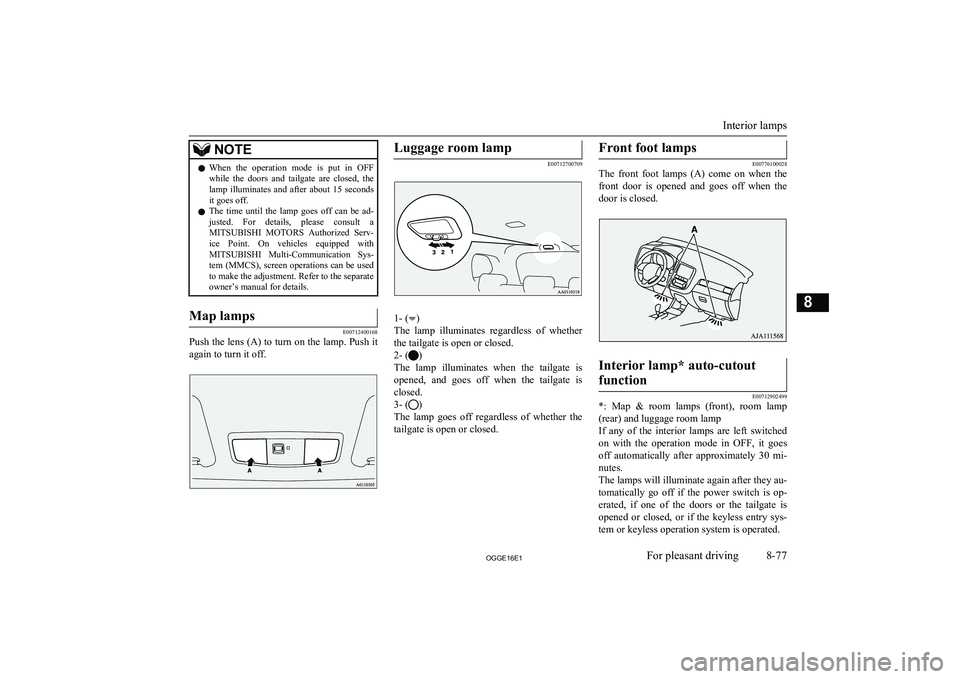
NOTElWhen the operation mode is put in OFF
while the doors and tailgate are closed, the
lamp illuminates and after about 15 seconds it goes off.
l The time until the lamp goes off can be ad-
justed. For details, please consult a
MITSUBISHI MOTORS Authorized Serv-
ice Point. On vehicles equipped with
MITSUBISHI Multi-Communication Sys-
tem (MMCS), screen operations can be used
to make the adjustment. Refer to the separate
owner’s manual for details.Map lamps
E00712400168
Push the lens (A) to turn on the lamp. Push it
again to turn it off.
Luggage room lamp
E00712700709
1- ()
The lamp illuminates regardless of whether the tailgate is open or closed.
2- (
)
The lamp illuminates when the tailgate is opened, and goes off when the tailgate is
closed.
3- (
)
The lamp goes off regardless of whether the tailgate is open or closed.
Front foot lamps
E00776100028
The front foot lamps (A) come on when the
front door is opened and goes off when the
door is closed.
Interior lamp* auto-cutout
function
E00712902499
*: Map & room lamps (front), room lamp (rear) and luggage room lamp
If any of the interior lamps are left switched
on with the operation mode in OFF, it goes off automatically after approximately 30 mi- nutes.
The lamps will illuminate again after they au- tomatically go off if the power switch is op-
erated, if one of the doors or the tailgate is opened or closed, or if the keyless entry sys-
tem or keyless operation system is operated.
Interior lamps
8-77OGGE16E1For pleasant driving8
Page 410 of 490
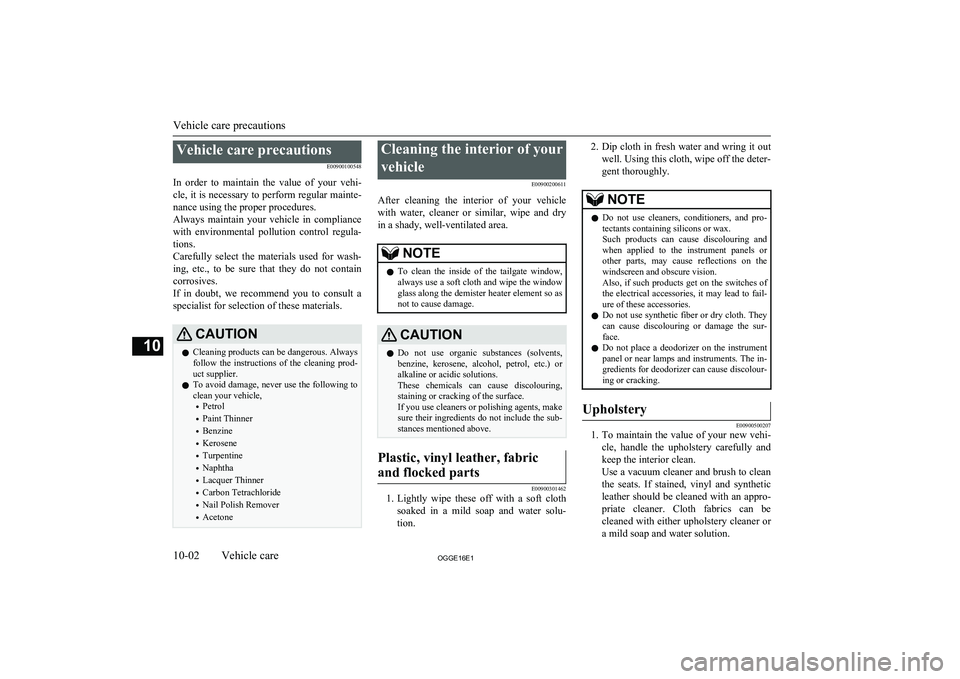
Vehicle care precautionsE00900100548
In order to maintain the value of your vehi- cle, it is necessary to perform regular mainte- nance using the proper procedures.
Always maintain your vehicle in compliance
with environmental pollution control regula- tions.
Carefully select the materials used for wash- ing, etc., to be sure that they do not contain
corrosives.
If in doubt, we recommend you to consult a specialist for selection of these materials.CAUTIONl Cleaning products can be dangerous. Always
follow the instructions of the cleaning prod- uct supplier.
l To avoid damage, never use the following to
clean your vehicle,
• Petrol
• Paint Thinner
• Benzine
• Kerosene
• Turpentine
• Naphtha
• Lacquer Thinner
• Carbon Tetrachloride
• Nail Polish Remover
• AcetoneCleaning the interior of your
vehicle E00900200611
After cleaning the interior of your vehicle with water, cleaner or similar, wipe and dry
in a shady, well-ventilated area.NOTEl To clean the inside of the tailgate window,
always use a soft cloth and wipe the windowglass along the demister heater element so as
not to cause damage.CAUTIONl Do not use organic substances (solvents,
benzine, kerosene, alcohol, petrol, etc.) or alkaline or acidic solutions.
These chemicals can cause discolouring, staining or cracking of the surface.
If you use cleaners or polishing agents, make
sure their ingredients do not include the sub- stances mentioned above.Plastic, vinyl leather, fabric
and flocked parts
E00900301462
1. Lightly wipe these off with a soft cloth
soaked in a mild soap and water solu- tion.
2. Dip cloth in fresh water and wring it out
well. Using this cloth, wipe off the deter-
gent thoroughly.NOTEl Do not use cleaners, conditioners, and pro-
tectants containing silicons or wax.
Such products can cause discolouring and when applied to the instrument panels orother parts, may cause reflections on the windscreen and obscure vision.
Also, if such products get on the switches of
the electrical accessories, it may lead to fail-
ure of these accessories.
l Do not use synthetic fiber or dry cloth. They
can cause discolouring or damage the sur- face.
l Do not place a deodorizer on the instrument
panel or near lamps and instruments. The in-gredients for deodorizer can cause discolour-
ing or cracking.Upholstery
E00900500207
1. To maintain the value of your new vehi-
cle, handle the upholstery carefully and
keep the interior clean.
Use a vacuum cleaner and brush to clean
the seats. If stained, vinyl and synthetic leather should be cleaned with an appro- priate cleaner. Cloth fabrics can be cleaned with either upholstery cleaner or
a mild soap and water solution.
Vehicle care precautions
10-02OGGE16E1Vehicle care10
Page 433 of 490
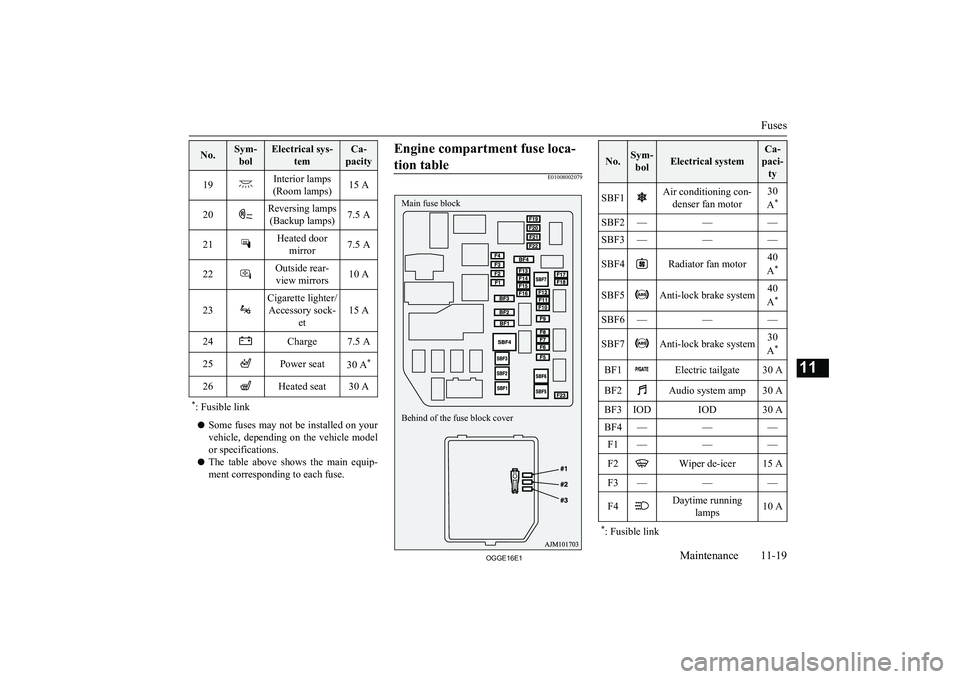
No.Sym-bolElectrical sys- temCa-
pacity19Interior lamps
(Room lamps)15 A20Reversing lamps (Backup lamps)7.5 A21Heated door mirror7.5 A22Outside rear-view mirrors10 A23
Cigarette lighter/ Accessory sock- et
15 A24Charge7.5 A25Power seat30 A*26Heated seat30 A*
: Fusible link
l Some fuses may not be installed on your
vehicle, depending on the vehicle model
or specifications.
l The table above shows the main equip-
ment corresponding to each fuse.
Engine compartment fuse loca-
tion table
E01008002079
No.Sym- bolElectrical system
Ca-
paci- tySBF1Air conditioning con- denser fan motor30
A *SBF2———SBF3———SBF4Radiator fan motor40
A *SBF5Anti-lock brake system40
A *SBF6———SBF7Anti-lock brake system30
A *BF1Electric tailgate30 ABF2Audio system amp30 ABF3IODIOD30 ABF4———F1———F2Wiper de-icer15 AF3———F4Daytime running
lamps10 A*: Fusible link
Fuses
11-19OGGE16E1Maintenance11 Main fuse block
Behind of the fuse block cover